Oscilloscopes
-
Top salesExpert choice
 Pico Technology 2206B MSO
Pico Technology 2206B MSOOscilloscope, 50 MHz, 2 + 16 channels, 1 GS/s
Price on request
In stock
Product code: 3030007
Record length: 32 M points
Vertical resolution: 8 bits
Waveforms per second: 80 000
An inexpensive oscilloscope with large memory and a 16-channel logic analyzer.
-
Top salesExpert choice
 Pico Technology 6424E
Pico Technology 6424EOscilloscope, 500 MHz, 4 + 16 channels, 5 GS/s
Price on request
On order
Product code: 3030022
Record length: 4 000 M points
Vertical resolution: 8 – 12 bits
Waveforms per second: 300 000
Digital oscilloscope with high-resolution ADC, performs 15 automatic measurements.
-
Top sales
 Tektronix MDO34-BW-200
Tektronix MDO34-BW-200Oscilloscope, 200 MHz, 4 + 16 channels, 2.5 GS/s
From 172 002 UAH
On order
Product code: 3030085
Record length: 40 M points 50 M points
Vertical resolution: 8 bits
Waveforms per second: 235 000
Spectrum analysis: 9 kHz – 1 GHz 9 kHz – 3 GHz
Professional digital oscilloscope with built-in spectrum analyzer.
-
Expert choice
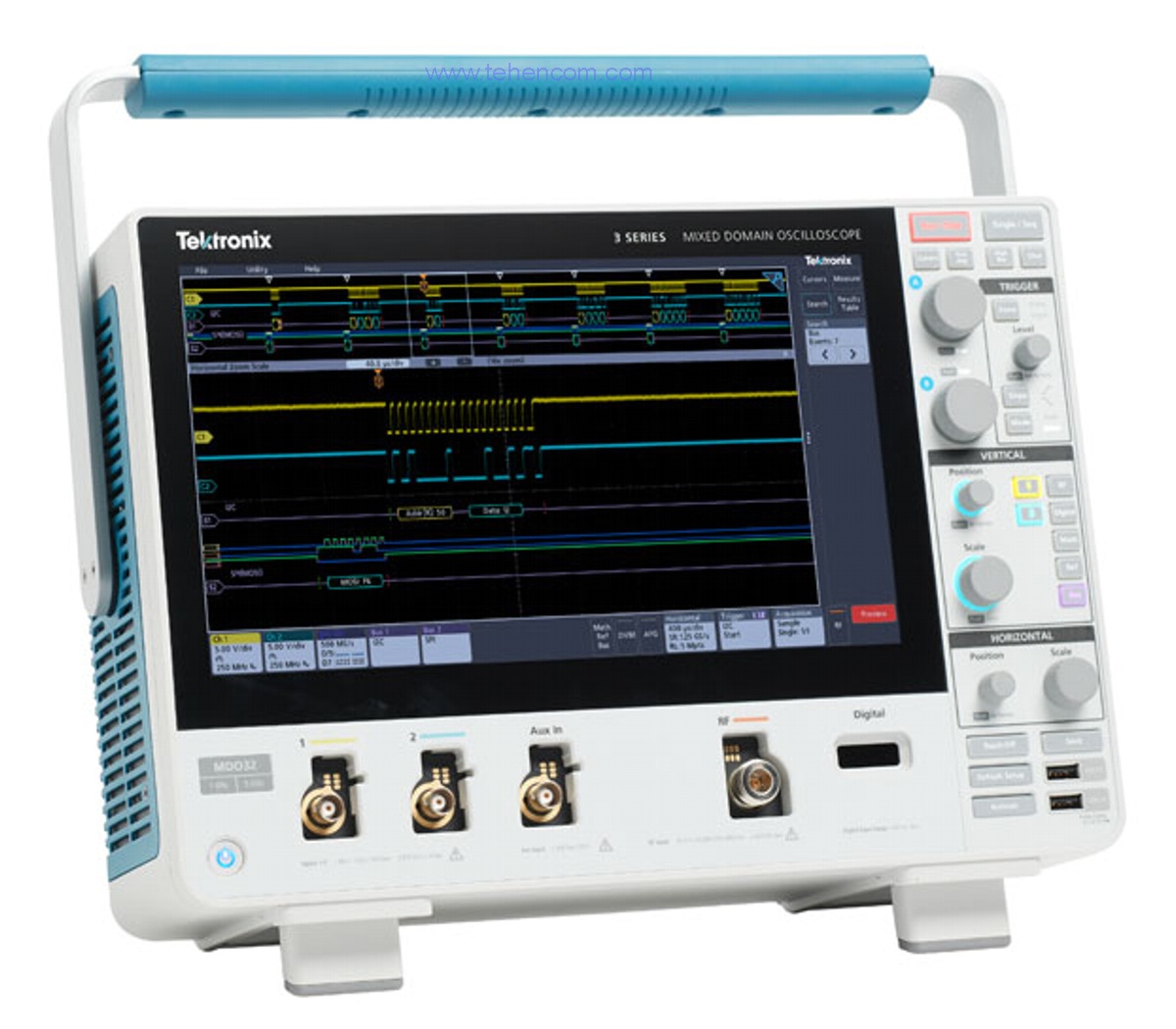 Tektronix MDO32-BW-1000
Tektronix MDO32-BW-1000Oscilloscope, 1 GHz, 2 + 16 channels, 5 GS/s
From 172 002 UAH
On order
Product code: 3030090
Record length: 20 M points 30 M points
Vertical resolution: 8 bits
Waveforms per second: 280 000
Spectrum analysis: 9 kHz – 1 GHz 9 kHz – 3 GHz
Professional digital oscilloscope with built-in spectrum analyzer.
-
Expert choice
 Tektronix DPO72004DX
Tektronix DPO72004DXOscilloscope, 20 GHz, 4 channels, 100 GS/s
Price on request
On order
Product code: 3030052
Record length: 250 M points 2 000 M points
Vertical resolution: 8 bits
Waveforms per second: 300 000
High frequency oscilloscope with unique signal analysis capabilities.
-
Expert choice
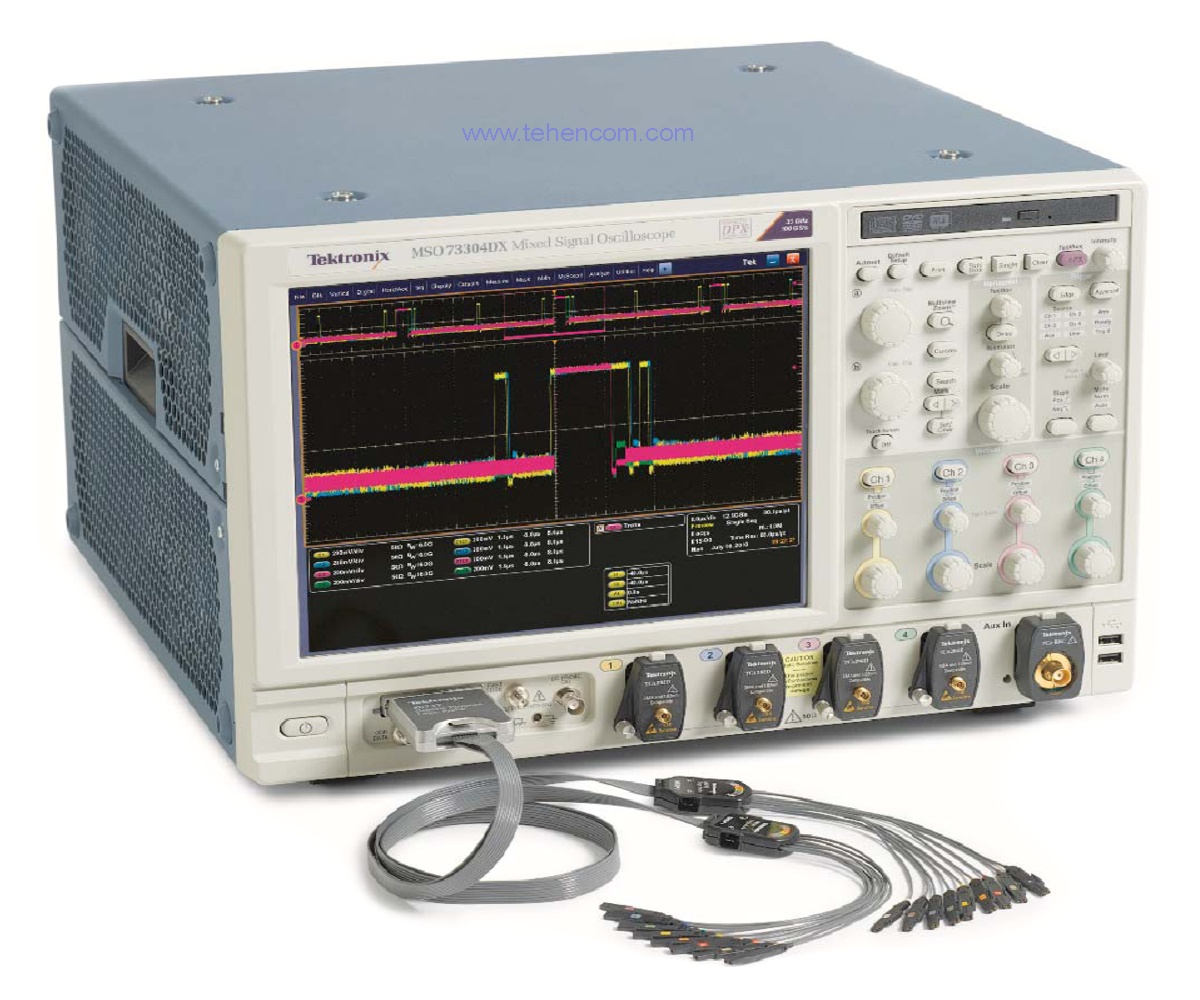 Tektronix MSO70804DX
Tektronix MSO70804DXOscilloscope, 8 GHz, 4 + 16 channels, 100 GS/s
Price on request
On order
Product code: 3030047
Record length: 312.5 M points 2 500 M points
Vertical resolution: 8 bits
Waveforms per second: 300 000
Oscilloscope for working with analog and digital signals in the gigahertz range.
-
Expert choice
 Pico Technology 5444D MSO
Pico Technology 5444D MSOOscilloscope, 200 MHz, 4 + 16 channels, 1 GS/s
Price on request
On order
Product code: 3030045
Record length: 512 M points
Vertical resolution: 8 – 16 bits
Waveforms per second: 130 000
High-quality digital oscilloscope with hardware ADC resolution up to 16 bits.
-
Expert choice
 Pico Technology 5244D
Pico Technology 5244DOscilloscope, 200 MHz, 2 channels, 1 GS/s
Price on request
On order
Product code: 3030042
Record length: 512 M points
Vertical resolution: 8 – 16 bits
Waveforms per second: 130 000
-
Top sales
 Pico Technology 5243D
Pico Technology 5243DOscilloscope, 100 MHz, 2 channels, 1 GS/s
Price on request
On order
Product code: 3030038
Record length: 256 M points
Vertical resolution: 8 – 16 bits
Waveforms per second: 130 000
-
Expert choice
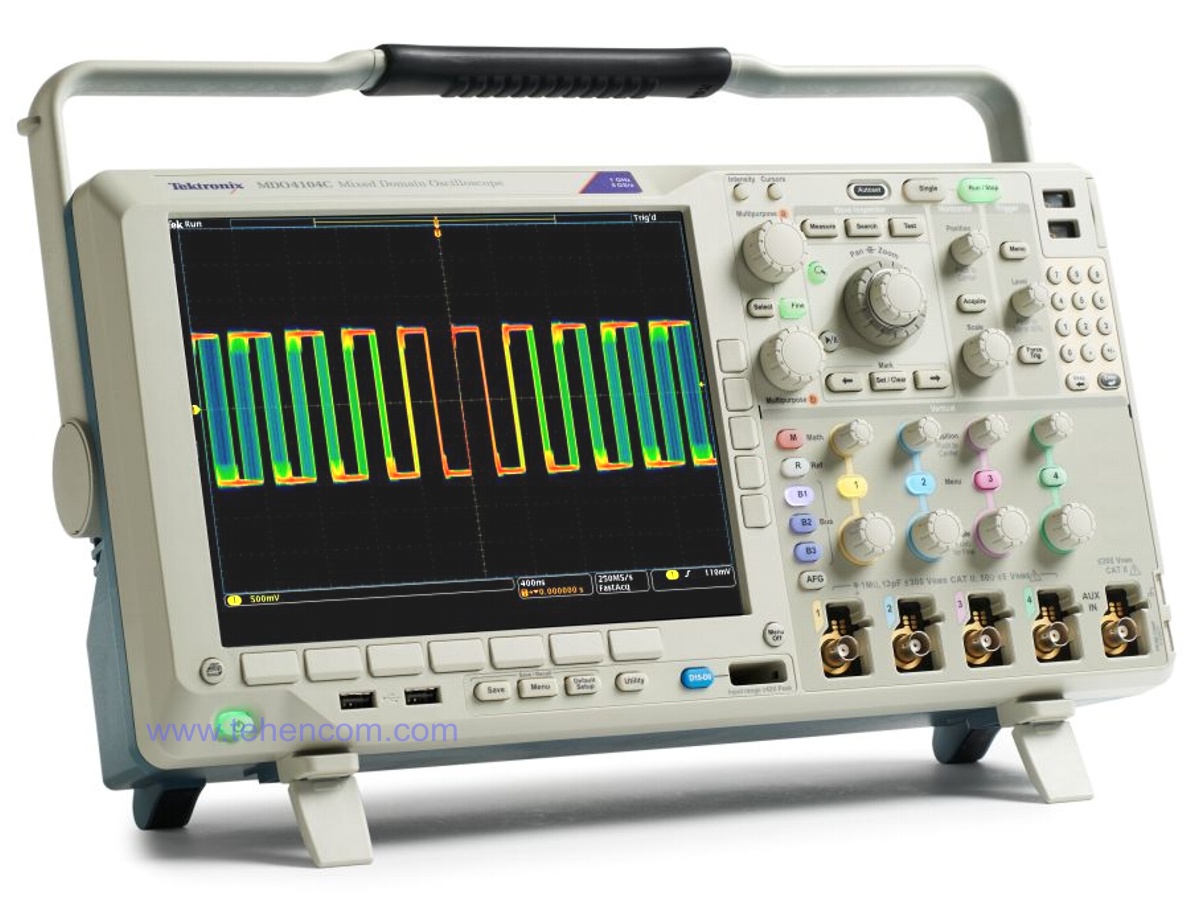 Tektronix MDO4104C
Tektronix MDO4104COscilloscope, 1 GHz, 4 + 16 channels, 5 GS/s
Price on request
On order
Product code: 3030033
Record length: 80 M points 100 M points
Vertical resolution: 8 bits
Waveforms per second: 340 000
Spectrum analysis: 9 kHz – 3 GHz 9 kHz – 6 GHz
Functional oscilloscope for measuring conventional and RF signals.
-
Novelty
 Pico Technology 6428E-D
Pico Technology 6428E-DOscilloscope, 3 GHz, 4 + 16 channels, 10 GS/s
Price on request
On order
Product code: 3030029
Record length: 4 000 M points
Vertical resolution: 8 – 12 bits
Waveforms per second: 300 000
-
Expert choice
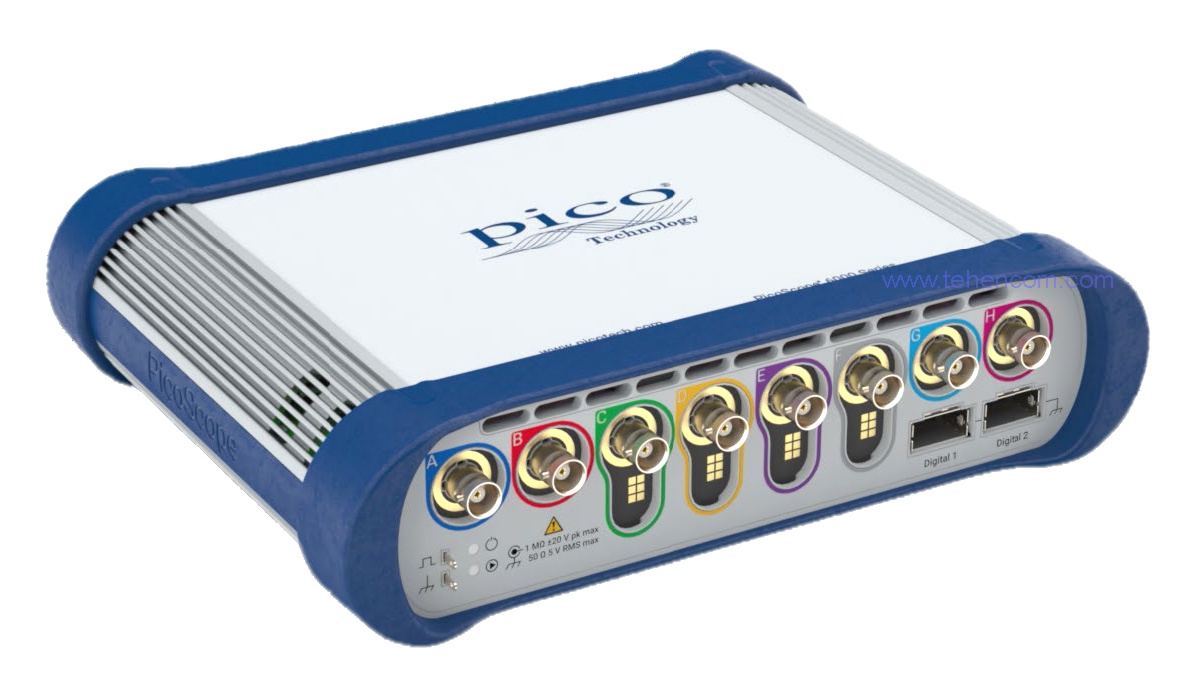 Pico Technology 6824E
Pico Technology 6824EOscilloscope, 500 MHz, 8 + 16 channels, 5 GS/s
Price on request
On order
Product code: 3030024
Record length: 4 000 M points
Vertical resolution: 8 – 12 bits
Waveforms per second: 300 000
-
Top sales
 Pico Technology 6403E
Pico Technology 6403EOscilloscope, 300 MHz, 4 + 16 channels, 2.5 GS/s
Price on request
On order
Product code: 3030020
Record length: 1 000 M points
Vertical resolution: 8 bits
Waveforms per second: 300 000
-
Expert choice
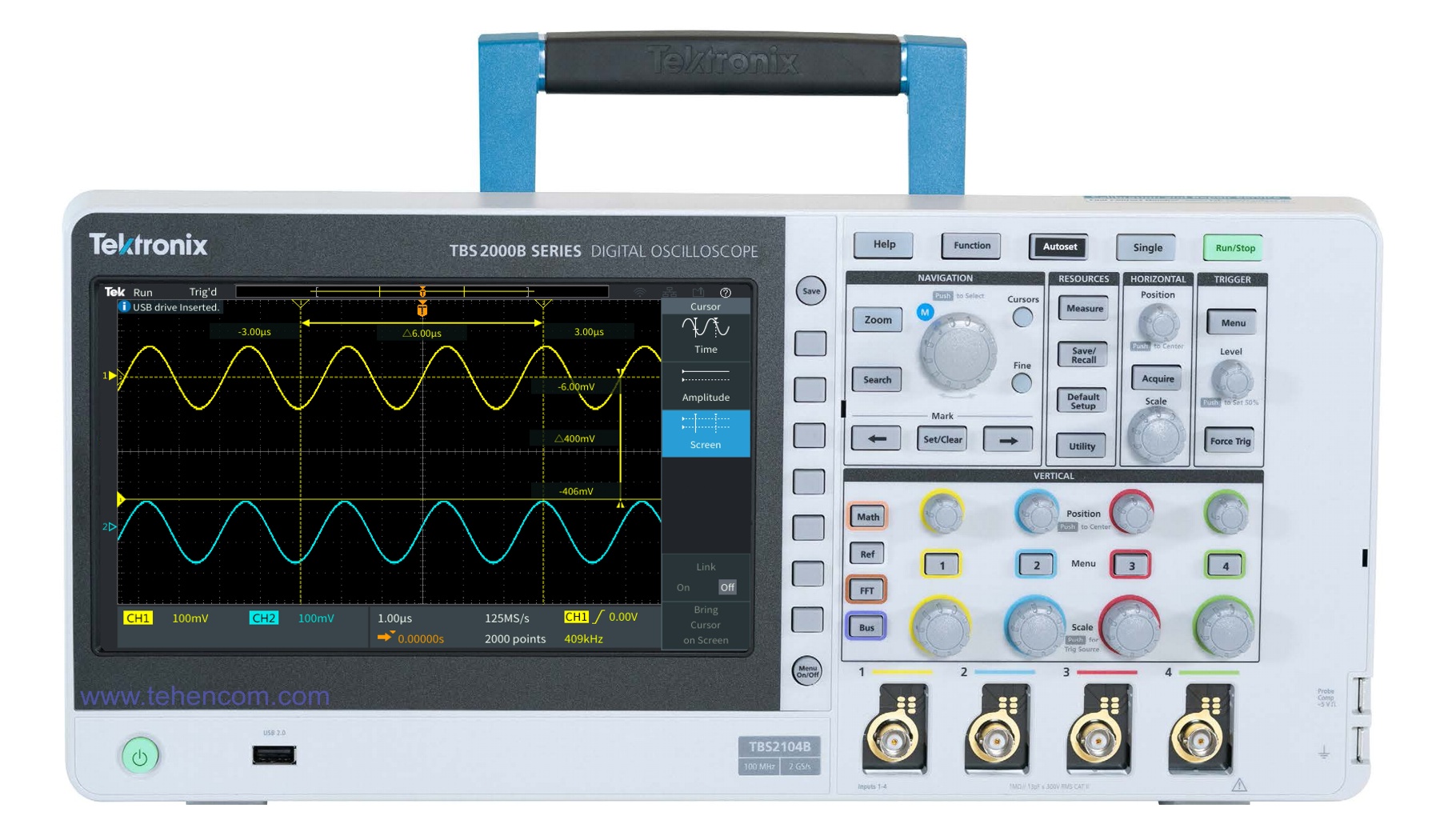 Tektronix TBS2104B
Tektronix TBS2104BOscilloscope, 100 MHz, 4 channels, 2 GS/s
Price on request
On order
Product code: 3030017
Record length: 20 M points
Vertical resolution: 8 bits
Waveforms per second: 100
Practical digital oscilloscope with four analog channels.
-
Top sales
 Pico Technology 2206B
Pico Technology 2206BOscilloscope, 50 MHz, 2 channels, 500 MS/s
Price on request
On order
Product code: 3030005
Record length: 32 M points
Vertical resolution: 8 bits
Waveforms per second: 80 000
-
 Tektronix MDO32-BW-200
Tektronix MDO32-BW-200Oscilloscope, 200 MHz, 2 + 16 channels, 2.5 GS/s
From 172 002 UAH
On order
Product code: 3030084
Record length: 20 M points 30 M points
Vertical resolution: 8 bits
Waveforms per second: 235 000
Spectrum analysis: 9 kHz – 1 GHz 9 kHz – 3 GHz
Professional digital oscilloscope with built-in spectrum analyzer.
-
 Tektronix MDO32-BW-350
Tektronix MDO32-BW-350Oscilloscope, 350 MHz, 2 + 16 channels, 2.5 GS/s
From 172 002 UAH
On order
Product code: 3030086
Record length: 20 M points 30 M points
Vertical resolution: 8 bits
Waveforms per second: 235 000
Spectrum analysis: 9 kHz – 1 GHz 9 kHz – 3 GHz
Professional digital oscilloscope with built-in spectrum analyzer.
-
 Tektronix MDO34-BW-350
Tektronix MDO34-BW-350Oscilloscope, 350 MHz, 4 + 16 channels, 2.5 GS/s
From 172 002 UAH
On order
Product code: 3030087
Record length: 40 M points 50 M points
Vertical resolution: 8 bits
Waveforms per second: 235 000
Spectrum analysis: 9 kHz – 1 GHz 9 kHz – 3 GHz
Professional digital oscilloscope with built-in spectrum analyzer.
-
 Tektronix MDO32-BW-500
Tektronix MDO32-BW-500Oscilloscope, 500 MHz, 2 + 16 channels, 2.5 GS/s
From 172 002 UAH
On order
Product code: 3030088
Record length: 20 M points 30 M points
Vertical resolution: 8 bits
Waveforms per second: 235 000
Spectrum analysis: 9 kHz – 1 GHz 9 kHz – 3 GHz
Professional digital oscilloscope with built-in spectrum analyzer.
-
 Tektronix MDO34-BW-500
Tektronix MDO34-BW-500Oscilloscope, 500 MHz, 4 + 16 channels, 2.5 GS/s
From 172 002 UAH
On order
Product code: 3030089
Record length: 40 M points 50 M points
Vertical resolution: 8 bits
Waveforms per second: 235 000
Spectrum analysis: 9 kHz – 1 GHz 9 kHz – 3 GHz
Professional digital oscilloscope with built-in spectrum analyzer.
-
 Tektronix MDO34-BW-1000
Tektronix MDO34-BW-1000Oscilloscope, 1 GHz, 4 + 16 channels, 5 GS/s
From 172 002 UAH
On order
Product code: 3030091
Record length: 40 M points 50 M points
Vertical resolution: 8 bits
Waveforms per second: 280 000
Spectrum analysis: 9 kHz – 1 GHz 9 kHz – 3 GHz
Professional digital oscilloscope with built-in spectrum analyzer.
-
 Tektronix MSO73304DX
Tektronix MSO73304DXOscilloscope, 33 GHz, 4 + 16 channels, 100 GS/s
Price on request
On order
Product code: 3030059
Record length: 312.5 M points 2 500 M points
Vertical resolution: 8 bits
Waveforms per second: 300 000
-
 Tektronix DPO73304DX
Tektronix DPO73304DXOscilloscope, 33 GHz, 4 channels, 100 GS/s
Price on request
On order
Product code: 3030058
Record length: 250 M points 2 000 M points
Vertical resolution: 8 bits
Waveforms per second: 300 000
-
 Tektronix MSO72504DX
Tektronix MSO72504DXOscilloscope, 25 GHz, 4 + 16 channels, 100 GS/s
Price on request
On order
Product code: 3030057
Record length: 312.5 M points 2 500 M points
Vertical resolution: 8 bits
Waveforms per second: 300 000
-
 Tektronix DPO72504DX
Tektronix DPO72504DXOscilloscope, 25 GHz, 4 channels, 100 GS/s
Price on request
On order
Product code: 3030056
Record length: 250 M points 2 000 M points
Vertical resolution: 8 bits
Waveforms per second: 300 000
-
 Tektronix MSO72304DX
Tektronix MSO72304DXOscilloscope, 23 GHz, 4 + 16 channels, 100 GS/s
Price on request
On order
Product code: 3030055
Record length: 312.5 M points 2 500 M points
Vertical resolution: 8 bits
Waveforms per second: 300 000
-
 Tektronix DPO72304DX
Tektronix DPO72304DXOscilloscope, 23 GHz, 4 channels, 100 GS/s
Price on request
On order
Product code: 3030054
Record length: 250 M points 2 000 M points
Vertical resolution: 8 bits
Waveforms per second: 300 000
-
 Tektronix MSO72004DX
Tektronix MSO72004DXOscilloscope, 20 GHz, 4 + 16 channels, 100 GS/s
Price on request
On order
Product code: 3030053
Record length: 312.5 M points 2 500 M points
Vertical resolution: 8 bits
Waveforms per second: 300 000
-
 Tektronix MSO71604DX
Tektronix MSO71604DXOscilloscope, 16 GHz, 4 + 16 channels, 100 GS/s
Price on request
On order
Product code: 3030051
Record length: 312.5 M points 2 500 M points
Vertical resolution: 8 bits
Waveforms per second: 300 000
-
 Tektronix DPO71604DX
Tektronix DPO71604DXOscilloscope, 16 GHz, 4 channels, 100 GS/s
Price on request
On order
Product code: 3030050
Record length: 250 M points 2 000 M points
Vertical resolution: 8 bits
Waveforms per second: 300 000
-
 Tektronix MSO71254DX
Tektronix MSO71254DXOscilloscope, 12.5 GHz, 4 + 16 channels, 100 GS/s
Price on request
On order
Product code: 3030049
Record length: 312.5 M points 2 500 M points
Vertical resolution: 8 bits
Waveforms per second: 300 000
-
 Tektronix DPO71254DX
Tektronix DPO71254DXOscilloscope, 12.5 GHz, 4 channels, 100 GS/s
Price on request
On order
Product code: 3030048
Record length: 250 M points 2 000 M points
Vertical resolution: 8 bits
Waveforms per second: 300 000
-
 Tektronix DPO70804DX
Tektronix DPO70804DXOscilloscope, 8 GHz, 4 channels, 100 GS/s
Price on request
On order
Product code: 3030046
Record length: 250 M points 2 000 M points
Vertical resolution: 8 bits
Waveforms per second: 300 000
-
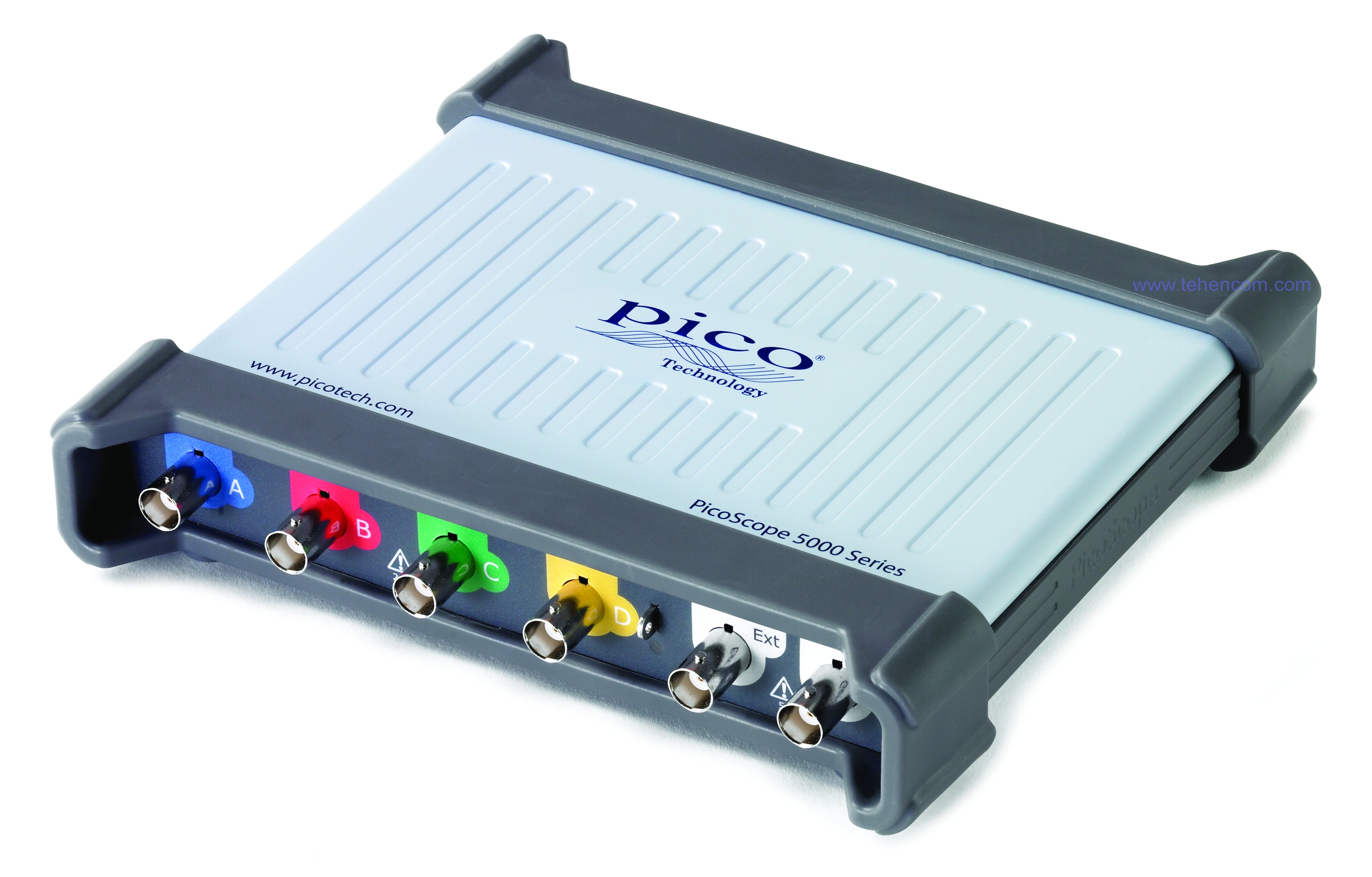 Pico Technology 5444D
Pico Technology 5444DOscilloscope, 200 MHz, 4 channels, 1 GS/s
Price on request
On order
Product code: 3030044
Record length: 512 M points
Vertical resolution: 8 – 16 bits
Waveforms per second: 130 000
-
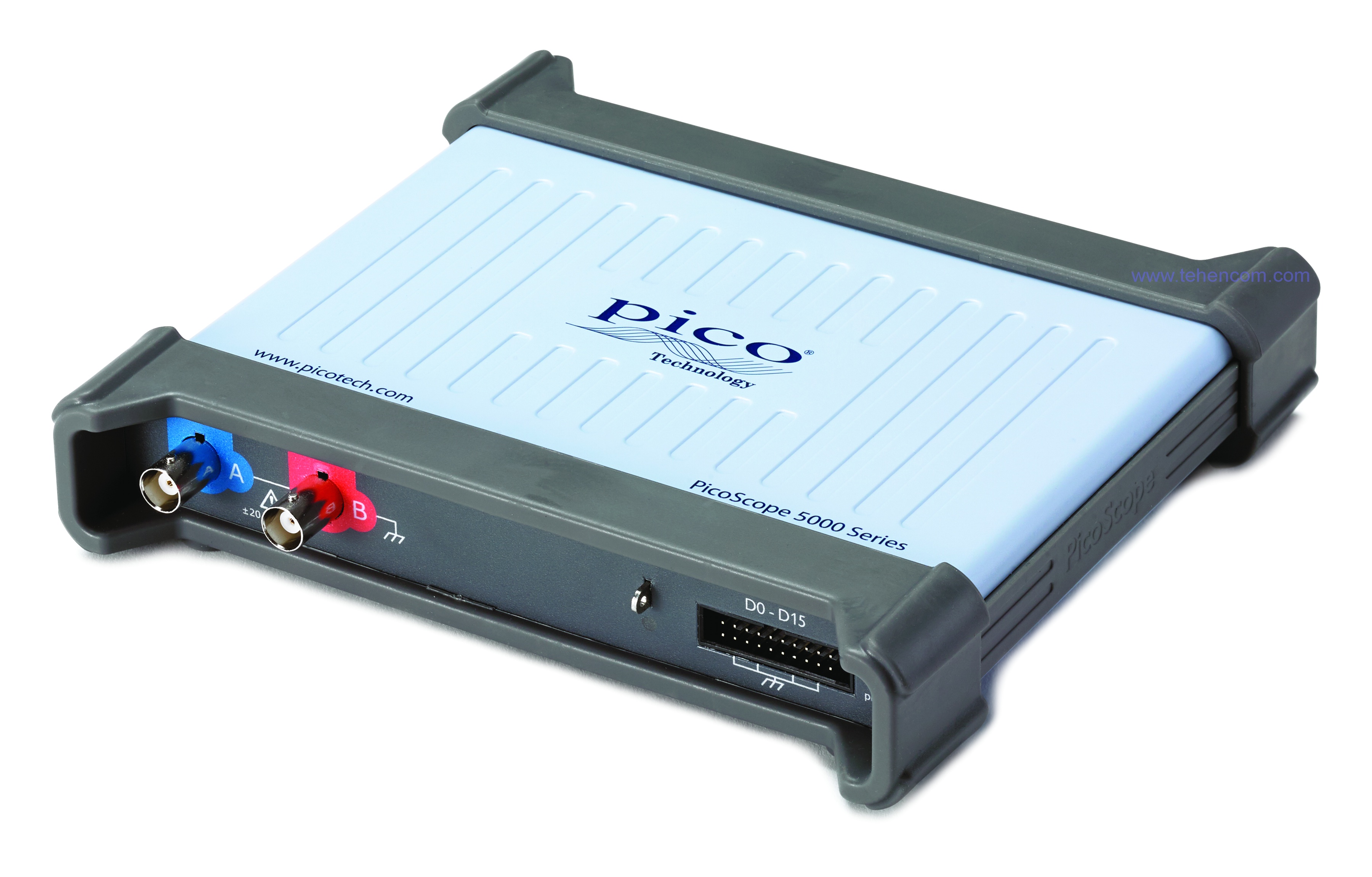 Pico Technology 5244D MSO
Pico Technology 5244D MSOOscilloscope, 200 MHz, 2 + 16 channels, 1 GS/s
Price on request
On order
Product code: 3030043
Record length: 512 M points
Vertical resolution: 8 – 16 bits
Waveforms per second: 130 000
-
 Pico Technology 5443D MSO
Pico Technology 5443D MSOOscilloscope, 100 MHz, 4 + 16 channels, 1 GS/s
Price on request
On order
Product code: 3030041
Record length: 256 M points
Vertical resolution: 8 – 16 bits
Waveforms per second: 130 000
General information
A digital oscilloscope is an indispensable instrument for any laboratory, with which you can directly observe, record and analyze electrical signals. Thanks to continuous improvement and the addition of new functions, modern digital oscilloscopes successfully solve more and more practical problems. We offer hundreds of oscilloscope models from 10 MHz to 80 GHz: classic laboratory, USB, portable and rackmount. In addition to conventional real-time oscilloscopes, the offer also includes sampling oscilloscopes, which are excellent for studying periodic signals.
Best models
This table contains the best models of oscilloscopes with the status of Top sales or Expert selection. Such models have a high price / capability ratio, so they should be paid attention first of all. The table is interactive, any column can be sorted in ascending or descending order.
| Model |
Bandwidth
|
Analog channels
|
Digital channels
|
Sample rate
|
Vertical resolution
|
Waveforms per second
|
|---|---|---|---|---|---|---|
|
Top sales
|
50 MHz | 2 | — | 500 MS/s | 8 bits | 80 000 |
|
Top sales
Expert choice
|
50 MHz | 2 | 16 | 1 GS/s | 8 bits | 80 000 |
|
Expert choice
|
100 MHz | 4 | — | 2 GS/s | 8 bits | 100 |
|
Top sales
|
300 MHz | 4 | 8 16 | 2.5 GS/s | 8 bits | 300 000 |
|
Top sales
Expert choice
|
500 MHz | 4 | 8 16 | 5 GS/s | 8 – 12 bits | 300 000 |
|
Expert choice
|
500 MHz | 8 | 8 16 | 5 GS/s | 8 – 12 bits | 300 000 |
|
Expert choice
|
1 GHz | 4 | 16 | 5 GS/s | 8 bits | 340 000 |
|
Top sales
|
100 MHz | 2 | — | 1 GS/s | 8 – 16 bits | 130 000 |
|
Expert choice
|
200 MHz | 2 | — | 1 GS/s | 8 – 16 bits | 130 000 |
|
Expert choice
|
200 MHz | 4 | 16 | 1 GS/s | 8 – 16 bits | 130 000 |
|
Expert choice
|
8 GHz | 4 | 16 | 100 GS/s | 8 bits | 300 000 |
|
Expert choice
|
20 GHz | 4 | — | 100 GS/s | 8 bits | 300 000 |
|
Top sales
|
200 MHz | 4 | 16 | 2.5 GS/s | 8 bits | 235 000 |
|
Expert choice
|
1 GHz | 2 | 16 | 5 GS/s | 8 bits | 280 000 |
All models of oscilloscopes
This table shows all models of oscilloscopes. You can sort by any of the characteristics by simply clicking on its name in the table. To see all the characteristics of certain models, add them to the comparison.
| Model |
Bandwidth
|
Analog channels
|
Digital channels
|
Sample rate
|
Vertical resolution
|
Waveforms per second
|
|---|---|---|---|---|---|---|
| 10 MHz | 2 | — | 100 MS/s | 8 bits | 2 000 | |
| 25 MHz | 2 | — | 200 MS/s | 8 bits | 2 000 | |
| 25 MHz | 4 | — | 500 MS/s | 8 bits | 2 000 | |
| 25 MHz | 2 | 16 | 500 MS/s | 8 bits | 2 000 | |
|
Top sales
|
50 MHz | 2 | — | 500 MS/s | 8 bits | 80 000 |
| 50 MHz | 4 | — | 1 GS/s | 8 bits | 80 000 | |
|
Top sales
Expert choice
|
50 MHz | 2 | 16 | 1 GS/s | 8 bits | 80 000 |
| 70 MHz | 2 | — | 1 GS/s | 8 bits | 80 000 | |
| 70 MHz | 4 | — | 1 GS/s | 8 bits | 80 000 | |
| 70 MHz | 2 | 16 | 1 GS/s | 8 bits | 80 000 | |
| 100 MHz | 2 | — | 1 GS/s | 8 bits | 80 000 | |
| 100 MHz | 4 | — | 1 GS/s | 8 bits | 80 000 | |
| 100 MHz | 2 | 16 | 1 GS/s | 8 bits | 80 000 | |
| 70 MHz | 2 | — | 2 GS/s | 8 bits | 100 | |
| 70 MHz | 4 | — | 2 GS/s | 8 bits | 100 | |
| 100 MHz | 2 | — | 2 GS/s | 8 bits | 100 | |
|
Expert choice
|
100 MHz | 4 | — | 2 GS/s | 8 bits | 100 |
| 200 MHz | 2 | — | 2 GS/s | 8 bits | 100 | |
| 200 MHz | 4 | — | 2 GS/s | 8 bits | 100 | |
|
Top sales
|
300 MHz | 4 | 8 16 | 2.5 GS/s | 8 bits | 300 000 |
| 500 MHz | 4 | 8 16 | 5 GS/s | 8 bits | 300 000 | |
|
Top sales
Expert choice
|
500 MHz | 4 | 8 16 | 5 GS/s | 8 – 12 bits | 300 000 |
| 500 MHz | 8 | 8 16 | 5 GS/s | 8 bits | 300 000 | |
|
Expert choice
|
500 MHz | 8 | 8 16 | 5 GS/s | 8 – 12 bits | 300 000 |
| 750 MHz 500 MHz | 4 | 8 16 | 5 GS/s | 8 bits | 300 000 | |
| 750 MHz 500 MHz | 4 | 8 16 | 5 GS/s | 8 – 12 bits | 300 000 | |
| 1 GHz 500 MHz | 4 | 8 16 | 5 GS/s | 8 bits | 300 000 | |
| 1 GHz 500 MHz | 4 | 8 16 | 5 GS/s | 8 – 12 bits | 300 000 | |
|
Novelty
|
3 GHz | 4 | 8 16 | 10 GS/s | 8 – 12 bits | 300 000 |
| 200 MHz | 4 | 16 | 2.5 GS/s | 8 bits | 340 000 | |
| 350 MHz | 4 | 16 | 2.5 GS/s | 8 bits | 340 000 | |
| 500 MHz | 4 | 16 | 2.5 GS/s | 8 bits | 340 000 | |
|
Expert choice
|
1 GHz | 4 | 16 | 5 GS/s | 8 bits | 340 000 |
| 60 MHz | 2 | — | 1 GS/s | 8 – 16 bits | 130 000 | |
| 60 MHz | 2 | 16 | 1 GS/s | 8 – 16 bits | 130 000 | |
| 60 MHz | 4 | — | 1 GS/s | 8 – 16 bits | 130 000 | |
| 60 MHz | 4 | 16 | 1 GS/s | 8 – 16 bits | 130 000 | |
|
Top sales
|
100 MHz | 2 | — | 1 GS/s | 8 – 16 bits | 130 000 |
| 100 MHz | 2 | 16 | 1 GS/s | 8 – 16 bits | 130 000 | |
| 100 MHz | 4 | — | 1 GS/s | 8 – 16 bits | 130 000 | |
| 100 MHz | 4 | 16 | 1 GS/s | 8 – 16 bits | 130 000 | |
|
Expert choice
|
200 MHz | 2 | — | 1 GS/s | 8 – 16 bits | 130 000 |
| 200 MHz | 2 | 16 | 1 GS/s | 8 – 16 bits | 130 000 | |
| 200 MHz | 4 | — | 1 GS/s | 8 – 16 bits | 130 000 | |
|
Expert choice
|
200 MHz | 4 | 16 | 1 GS/s | 8 – 16 bits | 130 000 |
| 8 GHz | 4 | — | 100 GS/s | 8 bits | 300 000 | |
|
Expert choice
|
8 GHz | 4 | 16 | 100 GS/s | 8 bits | 300 000 |
| 12.5 GHz | 4 | — | 100 GS/s | 8 bits | 300 000 | |
| 12.5 GHz | 4 | 16 | 100 GS/s | 8 bits | 300 000 | |
| 16 GHz | 4 | — | 100 GS/s | 8 bits | 300 000 | |
| 16 GHz | 4 | 16 | 100 GS/s | 8 bits | 300 000 | |
|
Expert choice
|
20 GHz | 4 | — | 100 GS/s | 8 bits | 300 000 |
| 20 GHz | 4 | 16 | 100 GS/s | 8 bits | 300 000 | |
| 23 GHz | 4 | — | 100 GS/s | 8 bits | 300 000 | |
| 23 GHz | 4 | 16 | 100 GS/s | 8 bits | 300 000 | |
| 25 GHz | 4 | — | 100 GS/s | 8 bits | 300 000 | |
| 25 GHz | 4 | 16 | 100 GS/s | 8 bits | 300 000 | |
| 33 GHz | 4 | — | 100 GS/s | 8 bits | 300 000 | |
| 33 GHz | 4 | 16 | 100 GS/s | 8 bits | 300 000 | |
| 100 MHz | 2 | 16 | 2.5 GS/s | 8 bits | 235 000 | |
| 100 MHz | 4 | 16 | 2.5 GS/s | 8 bits | 235 000 | |
| 200 MHz | 2 | 16 | 2.5 GS/s | 8 bits | 235 000 | |
|
Top sales
|
200 MHz | 4 | 16 | 2.5 GS/s | 8 bits | 235 000 |
| 350 MHz | 2 | 16 | 2.5 GS/s | 8 bits | 235 000 | |
| 350 MHz | 4 | 16 | 2.5 GS/s | 8 bits | 235 000 | |
| 500 MHz | 2 | 16 | 2.5 GS/s | 8 bits | 235 000 | |
| 500 MHz | 4 | 16 | 2.5 GS/s | 8 bits | 235 000 | |
|
Expert choice
|
1 GHz | 2 | 16 | 5 GS/s | 8 bits | 280 000 |
| 1 GHz | 4 | 16 | 5 GS/s | 8 bits | 280 000 |
Additional equipment
In addition to the main list of oscilloscopes presented above, the following additional series are produced: PicoScope 3000D (USB, up to 200 MHz), with a built-in spectrum analyzer Tektronix MDO3, six-channel Tektronix MSO4 (up to 1.5 GHz), eight-channel Tektronix MSO5 (up to 2 GHz) and the most functional Tektronix MSO6 (up to 8 GHz).
Manufacturers of measuring equipment regularly develop and launch new models of oscilloscopes with expanded capabilities and improved performance. Some time after the start of sales of new models, old models and series are discontinued. A complete list of discontinued oscilloscopes, including proposed replacements, can be found here: discontinued oscilloscopes.
Video reviews
Better to see once than hear a hundred times. This video collection from our YouTube channel is dedicated exclusively to digital oscilloscopes: new products, interesting models, features of their application, standards and measurement techniques. We are constantly updating and supplementing this collection with new interesting materials on oscilloscope measurements and related topics. Subscribe to our channel to stay updated: YouTube channel of Tehencom.
Basic theory
Buying an inexpensive and high-quality oscilloscope is not always easy. When choosing a model, in addition to the standard parameters: number of channels, bandwidth and sample rate, it is necessary to take into account additional characteristics and capabilities of the oscilloscope: record length, sensitivity, speed of continuous waveform acquisition, presence of digital channels, type of built-in spectrum analyzer, standard measurements (period, frequency, delay, rise time, etc.), possibility and ease of programming, built-in digital interfaces, a set of additional functions, operating temperature range, quality and durability of the device, the reputation of the manufacturer, the professionalism and reliability of the supplier, the availability of a service center, warranty period and much more. In addition, you may need technical advice on the types of oscilloscopes produced: real-time and sampling.
The next section Documentation contains useful information on the theory and practice of using digital oscilloscopes, which will help you understand this issue and improve your professional level. For complex and unclear issues, write to us by e-mail or call, we will be happy to advise.
Documentation and useful materials
-
Tutorial on the basics of oscilloscope measurements
RU, 60 pages, 2 MB
-
Tutorial on the oscilloscope probes
RU, 60 pages, 4 MB
-
12 things to consider when choosing an oscilloscope
RU, 30 pages, 7 MB
-
Probes selection guide for Tektronix oscilloscopes
EN, 23 pages, 4 MB